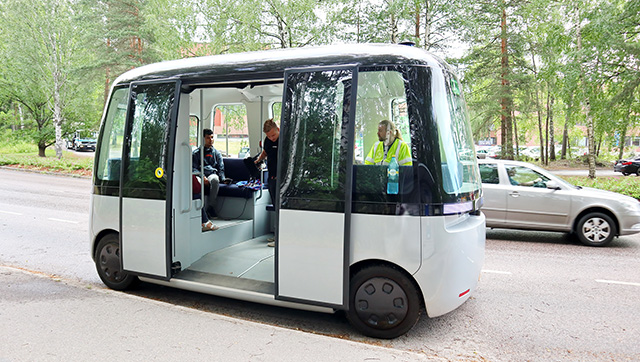Autonomous Technology: Transforming the College Experience
Autonomous shuttles could make transportation around campus easier for students, instructors, staff and visitors.
It’s no secret that parking seems to be a pain point among college students on any number of campuses across the United States. According to the New York Times, the University of Wisconsin-Madison has one parking space to every five people — and approximately 65,000 students. The campus plans to add an additional 2,200 parking spaces over the next 20 to 40 years, which seems like a long time for a campus and student body that is continuously growing. In fact, the application rate at the University of Wisconsin-Madison increased from 2017 to 2018 by 20 percent.
Transportation and parking remain an ongoing issue among campuses everywhere. A college student at Florida Atlantic University recently highlighted her frustrations with campus parking. “I was rushing to class for a Monday morning lecture that began at 8 a.m. At 7:59, I was nowhere near the building for my course because I had to park so far away. I awkwardly walked in at 8:17 and interrupted the professor’s lecture. On top of that, I needed to arrive early to put finishing touches on a paper that was due at the beginning of class. If I had access to better, more reliable modes of transportation, I would take it.”
Among the many public state universities, most are thousands of acres wide. The University of Florida, for example, is sprawled over 2,000 acres of land. With bus systems unable to service the demand and not enough parking space available for students, an alternative transportation solution is desperately needed that is timely and efficient.
A Solution: Autonomous Vehicles
Autonomous vehicles (AV) have become a de facto mode of transportation for the future. While we’re still in the early stages of the evolution of this technology, fixed-course autonomous shuttle vehicles could be a true transportation solution for college campuses. The use of controlled-speed timed shuttles that would allow students to travel between campus destinations will be revolutionary for universities that experience crowding or issues with parking.

Photo: SariMe / Shutterstock.com
Autonomous shuttles can be a more efficient and eco-friendly method of transportation for students as well as providing a more relaxing mobility environment. Rather than students parking their vehicles and then traveling via foot to class, they can relax and work on schoolwork while the shuttle takes them to each destination. In fact, autonomous shuttle technology has already been introduced to several universities as a means of transportation. The University of Michigan and California State University have both recently incorporated autonomous shuttles (also known as “people-movers”) onto their campuses.
Furthermore, autonomous shuttles will be able to help students with physical disabilities where walking for what can sometimes be up to a mile to get from one class to another is difficult. While most universities have disability services available, very few of them include efficient, timely transportation. Providing an easier way to get around campus will greatly improve the overall college experience for disabled students and faculty.
The Safety Factor
Another benefit of autonomous shuttles is the safety. Autonomous vehicle technologies are advancing and improving every day. Today, an AV does not see and interpret its surroundings exactly as a human would and therefore lacks a certain level of intuition. On the other hand, autonomous vehicles react to motion and events at a rate of two to three times faster than a human can, and the use of artificial intelligence will continually improve the needed interpretive logic which will ultimately create a much safer transportation mode than human-driven vehicles.
Most importantly, autonomous vehicles don’t get distracted by their surroundings or mobile devices like students and other drivers often do. According to the 2016 Fatal Motor Vehicle Crashes report by NHTSA (the National Highway Traffic Safety Administration), human error and poor judgement are the leading causes of traffic accidents and deaths on our roadways. Federal and local governments, insurance companies, the medical community and other groups are pushing for the introduction of autonomous vehicles to reduce this alarming statistic. There is plenty of research to validate that autonomous vehicles and equipment will dramatically improve safety in all applications, making campuses safer when autonomous transportation is deployed.
In conclusion, with parking continuing to be an increasingly difficult (and expensive) problem on college and university campuses, providing students with an alternate mode of transportation could solve many campus transportation issues while providing other benefits. Bringing autonomous shuttles to campuses would greatly improve the overall safety and productivity of the students, instructors and staff and having innovative, eco-friendly and convenient options increases the attractiveness of campus life — an important consideration in the college selection process.
About the Author
Joe Moye, CEO of Beep (www.go-beep.com), has more than 25 years of technology leadership and management consulting experience in both the private and public sectors.